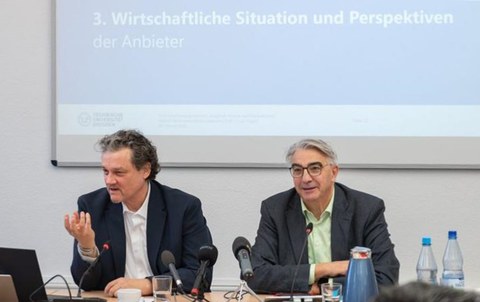Jan 17, 2025
Expert report on local media diversity presented

Prof. Lutz Hagen (left) at the presentation of the study on local diversity with TLM Director Jochen Fasco
What comes after the local newspaper? Unique, nationwide study on the structure and quality of local and regional media in Thuringia
So far, there are no news deserts, i.e. towns or districts without a local newspaper edition or even without any local reporting at all. However, the diversity of content and relevance of local newspapers continues to decline. Alternative local offerings by traditional media are only available in a few areas (e.g. local television, community radio). Pure online offerings on the web are often amateurish and of poor journalistic quality. This is shown by a recently published major study commissioned by the Thuringian State Media Authority (TLM) and led by Prof. Lutz Hagen (photo above - Prof. Lutz Hagen on the left at the presentation of the study on local diversity with TLM Director Jochen Fasco) from the Institute of Media and Communication at TU Dresden and spokesperson for the Boysen- TUD- Research Training Group.
So-called journalistic peripheral offerings are now very widespread on the Internet. This refers to blogs or portals on the web or profiles in social networks that focus on current local events, but are often created by amateurs or self-interested stakeholders in a journalistically inadequate manner.
Their quality often leaves a lot to be desired: public groups or profiles on the social web provide virtually no substantive information on politics and opinion-forming. Portals on the WWW can make a considerable contribution to the range and diversity in individual areas, especially in terms of the visibility of places and regions. However, they also often contain little politically relevant information for opinion-forming.
These findings are all the more worrying given that the majority of the population is very interested in local and regional issues. Media and channels with limited journalistic qualities are increasingly being used: Peripheral offerings from the open or closed social web are already among the most important sources in the 14 to 25 age group. In the overall population, official gazettes and municipal portals, as well as free advertising papers, also achieve considerable reach.
"The study is unique in Germany," says Lutz Hagen. "It covers all public offerings in the entire federal state and uses diverse and meaningful methods - from expert interviews, a survey of all providers and a representative public survey of the Thuringian population to a systematic content analysis. Jens Woelke (University of Münster) and the journalist and media consultant Peter Stawowy are involved in the implementation.
